...is this your first visit to my journal? Start on Day 1! Archive stored here: https://www.polartrec.com/expeditions/permafrost-and-community
Today was my last day in Nikolai! We had originally planned to stay through tomorrow, but with the cancelled trip to Telida, folks wanted to head back early. So it looks like we’ll be taking a 10 am flight in the morning.
I really can’t thank the community here enough. I know I’ve said this before, but Nikolai is gorgeous village, and the people here have all been so welcoming and gracious. I’m going to miss waving hello to everybody I pass, the conversations I run into as I’m wandering around, the quiet sounds of the village, and the friends I’ve made here. I can’t wait to come back. I spent a lot of the day plotting about how to do that.
First thing this morning, I woke up to catch the morning light for photographs. I haven’t felt especially motivated to take pictures the past couple days, because I was pretty discouraged about our change in travel plans, but since it’s my last day here, I woke up with a fire under my butt. Also a new optimism that I’m going to make it back again, which went a long way toward cheering me up. I headed straight for the fish wheel, because besides my photos of Bernie, I haven’t been happy with the pictures I’ve taken there. This time, there were at least ten fish caught by the wheel (I counted six salmon and four whitefish, but there were probably more underneath the water). As I was watching the wheel, a whitefish erupted out of the wheel and slid down into the holding area. A catch!


Everything was glowing this morning, with the cloud cover and the light. Nikolai is such an easy place to photograph in, because you have beautiful scenery to frame everything, but also every house looks different and there are always interesting things lying around. It’s easy to find evidence of what people have been up to, and I love places like that. Here are some other photos from my morning:


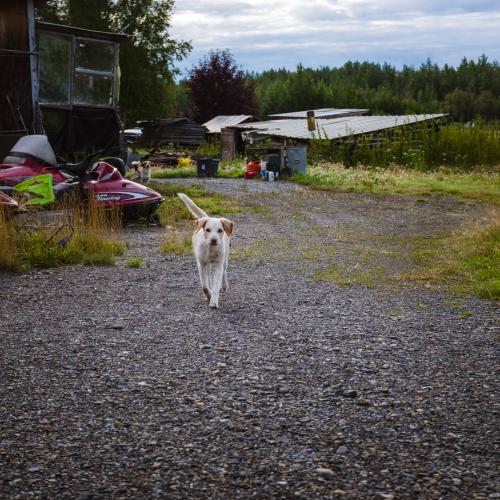
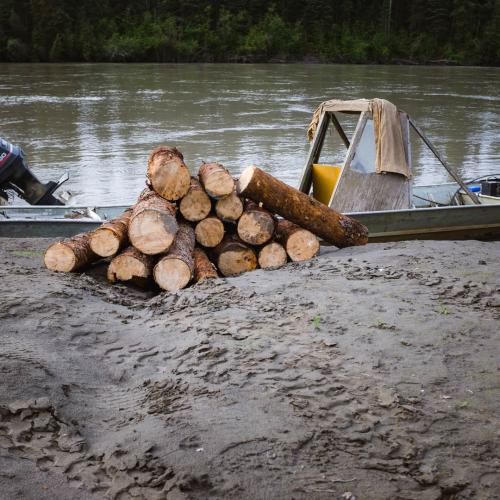
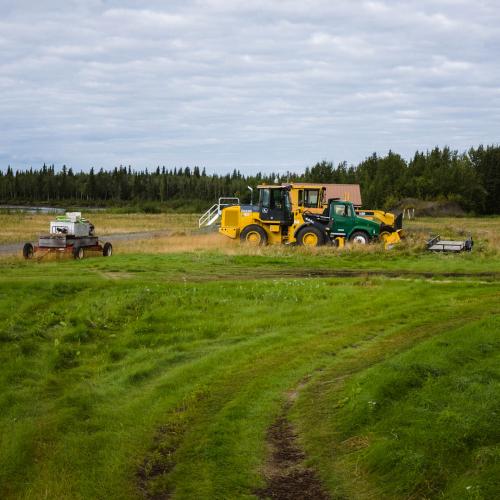

 Traces of the Iditarod in summer: dog teams come up off the river and rest here near these barrels.
Traces of the Iditarod in summer: dog teams come up off the river and rest here near these barrels.
I went back to eat breakfast, and then went back out to the field with Sasha and Santosh. We headed to Salmonberry Lake, where there is a monitoring station in an area with classic permafrost vegetation. From my view, this means an open stand of black spruce trees and very squishy ground (I’m sure Santosh and Sasha could elaborate better).
 Sasha in a black spruce forest.
Sasha in a black spruce forest.
 Squish!
Squish!
I asked Sasha why the forest is so open here, with trees that don’t grow very tall; he said low nutrients have something to do with it, and he suspects also the difficulty of growing on permafrost. In fact, black spruce is a good indicator of permafrost because it takes an extremely hardy tree to be able to handle it. Other Alaskan trees, like white spruce and birches, have a much harder time with what is essentially ice-cold bedrock a few feet below the surface of the ground.
 Recording data.
Recording data.
 A black spruce sapling growing out of the permafrost active layer.
A black spruce sapling growing out of the permafrost active layer.
 Got a portrait of Sasha.
Got a portrait of Sasha.
 This lake continues to be photogenic.
This lake continues to be photogenic.
On the way back, Santosh pulled out his GPS and started making notes of vegetation cover. What he was doing, in a nutshell, was recording a location and then creating a data point that described the area he was in. Later, he will enter these points into a computer program that surveys satellite imagery; each pixel that looks like the pixel he identified will be coded the same way. This is a way to build maps of permafrost in an area without having to physically visit each location.
 A map like the one Santosh is researching.
A map like the one Santosh is researching.
 Recording vegetation cover.
Recording vegetation cover.
In a couple places, we saw areas where there has been significant permafrost thaw. (If you want to sound fancy to a permafrost scientist, call this a “thermokarst.”) They’re easy to find because the ground sinks, the black spruce die, and trees like birch start to replace them. In newer thermokarsts, before the permafrost thaws to the point where all the moisture can drain away, you find a lot of water.
 Thermokarst formation tends to snowball, because water is very good at melting ice. The water seeps into the ground, which thaws permafrost, which creates more water, on and on and on.
Thermokarst formation tends to snowball, because water is very good at melting ice. The water seeps into the ground, which thaws permafrost, which creates more water, on and on and on.
At one thermokarst location, I asked Sasha what could have caused it. He said it was a disturbance of some kind—not fire, because that would have included a larger area, so probably some human activity. He said something as simple as a snowmachine or four-wheeler getting stuck and pulled out again could be enough to trigger permafrost thaw. 50 years ago, the climate might have been cold enough to stop the thaw before it got out of hand, but today, it is easier and easier to start the chain reaction that leads to a large thermokarst.
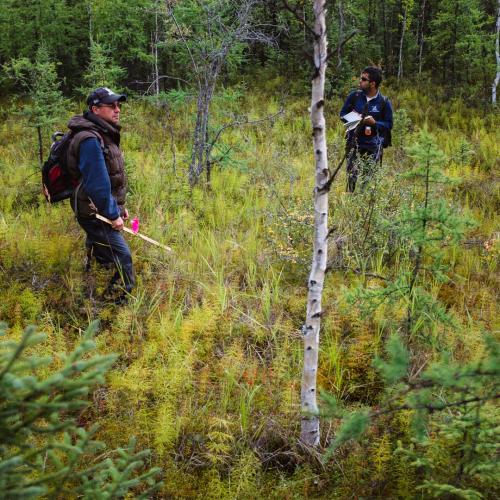 Standing in a thermokarst area. Around this depression, where a few birch trees are starting to grow, is a black spruce forest.
Standing in a thermokarst area. Around this depression, where a few birch trees are starting to grow, is a black spruce forest.
What Sasha and Santosh are finding with their data here is that permafrost is in critical danger of disappearing. Sasha likens it to a person running a temperature: above a certain level, you know there’s an issue. The permafrost around Nikolai is hovering worryingly close to 0° C, or 32° F.
After we got back from fieldwork, Sasha gave a presentation to the school, and the kids were remarkably attentive through the whole thing, even though some of them are very young. After he was done with his talk, one of the school staff asked how permafrost thaw might affect berries. Sasha didn’t sugar-coat anything. This community depends on the forest, and Nikolai’s forests depend on permafrost. If it disappears, all the foods the village depends on—berries, fish, moose, and more—will be impacted. One of the students, clearly concerned, asked “how are we going to eat?”
There’s not an easy answer to that.
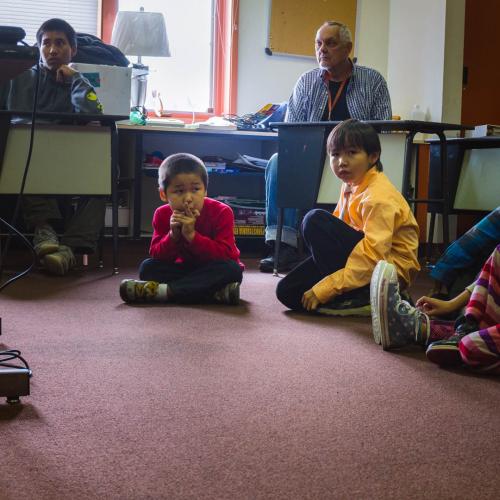 Students at Sasha's talk.
Students at Sasha's talk.
This afternoon, I was texting with my mom. She is a much happier person when she can go out running for hours (I don’t understand this compulsion, but I respect it), and has been going stir crazy with an injury that’s kept her even from walking much this summer. This week, finally, the doctor gave her the okay to start taking walks with light jogs mixed in. She lives in Boise, though, and the smoke is so bad that she can’t do it. It’s too smoky to take a walk.
Just a couple hours ago I was walking around in front of the lodge (there’s still a bear on the loose, so I didn’t want to go much farther), and I ran into Bernie, who you met on Day 7 at the fish wheel. We were swapping stories and he told me that he was down in Oregon last year with the Nikolai fire crew, fighting the Umpqua fire. I thanked him for it, and we got onto the topic—as I have with multiple people this trip—of the California fires. I remember thinking to myself before I came to Nikolai that I wanted to help communicate the issues this region of Alaska is dealing with when it comes to climate change, but in the end, most of the climate conversations I’ve had here are about the Lower 48. Nobody needs more evidence of climate change; what we do need is the collective will to push for policies to address it.
The people of the Upper Kuskokwim survive in the Arctic because they work as a community; similarly, none of us can slow climate change alone. To create an energy economy that doesn’t release heat-trapping gases into our atmosphere, we must strive for large-scale solutions that fix systemic issues, rather than putting the weight of responsibility on individual consumer actions. This is a big task, but it’s a possible one, and it’s necessary. I want a future where Talia is surrounded by lowbush cranberries as an elder, and where my children’s children don’t choke on smoke when they step outside. We each can help build momentum for civic action, and none of us are alone in that work.



Comments
Add new comment